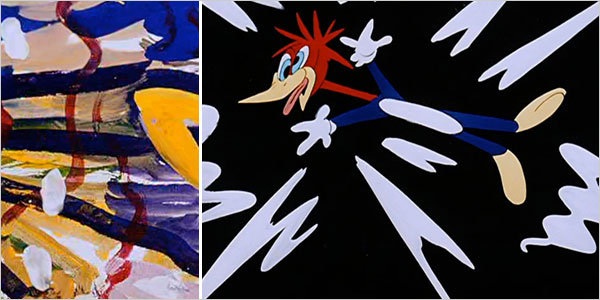Did animation pioneer Shamus Culhane secretly slip his own abstract paintings into 1940s Woody Woodpecker cartoons? Apparently so, according to cartoon historian Tom Klein writing in the new issue of Animation: An Interdisciplinary Journal.

From the New York Times:
“Culhane essentially ‘hid’ his artful excursions in plain sight, letting them rush past too rapidly for the notice of most of his audience,” Mr. Klein writes in the 15-page article, titled “Woody Abstracted: Film Experiments in the Cartoons of Shamus Culhane.” In the article Mr. Klein describes Mr. Culhane, who was credited in his work then as James Culhane, as a devotee of the avant-garde. He was influenced by the writings of Russian theorists like Sergei Eisenstein and Vsevolod Pudovkin, Mr. Klein writes, and spent evenings at the American Contemporary Gallery in Hollywood. There, he watched films by Fritz Lang and Jean Renoir, might have seen paintings by Oskar Fischinger and definitely “was inclined to wear a beret.”
Mr. Klein writes that one of (Culhane's) experiments was a two-second piece of an explosion in “Woody Dines Out,” from 1945. He finds the frames “improvised like visual music” in what Mr. Culhane acknowledged in his autobiography, “Talking Animals and Other People,” was an Eisenstein-inspired moment.
The longest such experimental sequence was in the seven-second steamroller smash-up in “The Loose Nut,” also from 1945. And, later in that cartoon, Woody is blown into an abstract configuration that Mr. Klein, in his article, calls “the convergence of animation and Soviet montage.”

No comments:
Post a Comment